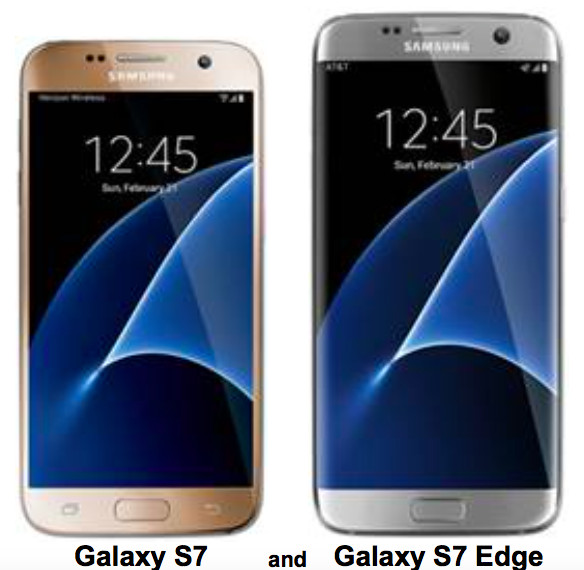Samsung mobile, famous for its AMOLED displays has targeted high brightness and daylight readability in their newest Galaxy S7 flagship offerings. The S7 and Edge achieved an almost 25% brightness increase over last year’s S6 model according to DisplayMate Labs and Dr. Ray Soneira recent published findings.
Even more impressive is news on the performance of the flexible display found in the Galaxy S7 Edge, Displaymate Labs said that OLED display on flexible plastic substrate, “…is now essentially the same as on a traditional glass substrate for the Galaxy S7, even at 500+ pixels per inch and 2560×1440 resolution.” Soneira sees this as essential for future display development, proclaiming that curved and flex displays are now at performance parity with the best performing flat substrate displays.
The DisplayMate Labs report states: “[C]urved and flexible displays are definitely the wave of the future because they offer many important visual and functional advantages for both mobile displays and TVs,” he said. Remarkably, the Galaxy S7 Edge mirrors the display performance measurements of the S7 and also offers all of the same basic display functions even though its made on a plastic substrate. Long term this can impact the ultimate form factor for future devices, seen as necessary to move to the next level in premium smartphone devices. For details see Tuesday’s Display Daily “Will Flagship Samsung S7 Sell?”
 Some added applications found on the curved S7 Edge display include user interface enhancements including:
Some added applications found on the curved S7 Edge display include user interface enhancements including:
- quick access to apps, widgets, menus, options,
- a rotating carrousel of edge screens that you can swipe and flip through with your finger to see the time, weather,
- color coded notifications like incoming and missed calls,messages and Emails,
- active news feeds that continuously scroll along the Edge
The new 5.1-inch 2560 x1440 pixel AMOLEDs found in the Galaxy S7 matches and even exceeds the highest ranking Galaxy S5 Note display, previously characterized as the “Best Performing Smartphone Display” ever tested by DisplayMate Labs. This is even more remarkable when considering the 20% component size reduction Samsung had to make in developing this next gen AMOLED display.
On daylight readability improvement, Soneira shoot-out report stated: “To be usable in high ambient light a display needs a dual combination of high Screen Brightness and low screen Reflectance – the Galaxy S7 has both. For most image content the Galaxy S7 provides over 440 cd/m² (luminance, which is a measure of brightness sometimes called nits), comparable or higher than most LCD displays in this size class. Its screen reflectance is 4.6 percent, close to the lowest that we have ever measured for a smartphone,” the report reads.
 Samsung has made consistent improvements in its AMOLED offering since 2010 (Google Nexus One) and a last place showing in the Industry Display Shoot-out against then popular LCD smartphones including Apple iPhones. According to Soneira, “In a span of just six years OLED display technology is now challenging and even exceeding the performance of the best LCDs. The Galaxy S7 continues this impressive systematic improvement in OLED displays and technology,” he said in this latest display Shoot-out report.
Samsung has made consistent improvements in its AMOLED offering since 2010 (Google Nexus One) and a last place showing in the Industry Display Shoot-out against then popular LCD smartphones including Apple iPhones. According to Soneira, “In a span of just six years OLED display technology is now challenging and even exceeding the performance of the best LCDs. The Galaxy S7 continues this impressive systematic improvement in OLED displays and technology,” he said in this latest display Shoot-out report.
The two new devices from Samsung were announced on Sunday at the Mobile World Congress in Barcelona, Spain to great fanfare and with the use of Virtual Reality (VR) to highlight the product launch. Oculus Rift owner and Facebook founder Mark Zuckerberg took to the Samsung stage to help promote the new flagship smartphones from Samsung, also used to power the Samsung Gear VR device that uses technology licensed from the Oculus Rift. Samsung also immediately kicked-off a media blitz running full page ads in major newspapers (Wall Street Journal, USA Today et al.) offering a free Gear VR and a six game software package from Samsung with a pre-order of the S7 or S7 Edge device.
The shoot-out from DisplayMate Labs is an in-depth analysis of the newest premium Smartphone offerings. This latest version covers the new flagship Galaxy S7 models from Samsung, the Korea based company that is still ranked as the world’s largest supplier of those devices. Click through for the full DisplayMate Galaxy S7 Display Shoot-Out and conclusions. – Steve Sechrist

